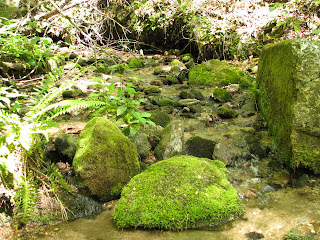While many of my neighbors apply pounds of chemistry to kill the moss in their lawns, I spend time on my knees (something my very religious Mother would have encouraged) pulling the grass from the moss one small clump at a time. Moss grows quite well under the gnarly branches of the red maple that shelters the front of our home at Hidden Springs from the often hot Southern sun.
Perhaps someday Aesthetics will turn its attention to other natural beauties. For example, the beauty of evolutionary biology as a species comes into being or the beauty of a natural system feeding the cycle of life and death…that would indeed be a substantial transdisciplinary leap into the connections that bind and liberate us all.
Connections.
Shallow depressions in the sandy mud alongside woodland pond.
Depressions made by a wandering raccoon, an animal so well adapted to feed on the clams buried beneath the surface of the sand that they fish by touch alone.
Connections.
The clams strain minute plankton, clarifying the water, cleaning it until it sparkles--growing inside their shells until a passing raccoon senses their presence beneath the sand, and....
Connections.
Plankton--tiny children of the sun using the basic elements of nature to create the stuff of life, to build their own living plant-selves from the sun and minerals that surround them in the water.
Connections.
Standing -- on the verge of the glassy waters watching the connections unfold, watching the interconnectedness take place.
Stepping -- carefully least I erase the trace of what has passed here...of the connections that have taken place here.
Wondering -- where I and mine belong in this web of life.
Sensing -- in those shallow wanderings the elements of nature flowing through me.
Knowing -- that someway, somehow I and mine have become separate from the primal patterns shifting and blending in the waters of the woodland pond.
Understanding-- that the separation is only temporary, can only be temporary, is only illusion.
Standing -- again-- in the shadows at the edge of the pond.
Watching--in my delight and in my fear.





